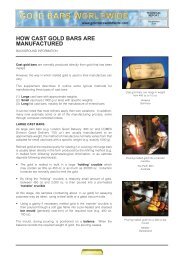Indian Gold Book:Indian Gold Book - Gold Bars Worldwide
Indian Gold Book:Indian Gold Book - Gold Bars Worldwide
Indian Gold Book:Indian Gold Book - Gold Bars Worldwide
You also want an ePaper? Increase the reach of your titles
YUMPU automatically turns print PDFs into web optimized ePapers that Google loves.
TRADITIONAL JEWELLERY RETAILERS<br />
There are approximately 300,000 “traditional” gold jewellery outlets. They are family-owned businesses.<br />
Less than 15,000 family retailers may account for 30% or more of gold jewellery sales nationwide.<br />
The exchange of old jewellery, coins and bars for new gold jewellery and buy backs for cash are standard transactions.<br />
Dishoarding may have supplied more than 40% of gold used to fabricate new jewellery in 2001.<br />
Large retailers report that their inventories have increased by 20 - 50% over the past 5 years. The inventory stock in<br />
total is unlikely to exceed 400 tonnes of fine gold.<br />
Many large retailers report that their profit margin on gold jewellery sales has fallen.<br />
Large showrooms are expected to increase their share of the jewellery market. The distribution network is expected to<br />
contract over time.<br />
BACKGROUND<br />
Family-owned jewellery retailers are generally categorised as “traditional jewellers”.<br />
The term is misleading as many are at the forefront of innovation.<br />
Although they may operate under the same names, especially in large cities, the outlets tend to be owned and run as<br />
separate and loosely associated businesses by fathers, sons, brothers, nephews, cousins and other close relatives.<br />
In their role as jewellery retailers, they act as dealers. They buy back and exchange jewellery at prices linked to the<br />
prevailing gold price. They also retail and buy back coins (and bars, if requested).<br />
Many are involved in other jewellery-related businesses and activities: fabrication, wholesaling, refining, coin fabrication and<br />
bullion dealing.<br />
Some large retailers in metropolitan and smaller cities also own showrooms outside India, mainly in the Gulf countries, but<br />
some also in Europe, the USA and elsewhere.<br />
Many large retailers also have non-precious metal related businesses. Many retailers sell jewellery as an ancillary product.<br />
NUMBER<br />
Since the repeal of the <strong>Gold</strong> (Control) Act in 1990, the number of jewellery outlets appears to have grown<br />
from 16,000 to approximately 300,000.<br />
Since the last <strong>Gold</strong> Control Statement in 1989, no statistics have been available. Trade estimates vary greatly from 250,000<br />
to several hundred thousand.<br />
Even within major metropolitan cities, trade estimates vary widely. In Mumbai, for example, estimates range from 4,000 to<br />
more than 10,000.<br />
The reason for the range in estimates is due mainly to the “uncountable” tens of thousands of very small outlets that have<br />
been established in cities, towns and many villages throughout India since 1990. Outlets that only sell silver or imitation<br />
jewellery also tend to be included.<br />
Retail distribution increased rapidly due to 4 main factors.<br />
• Many of the 380,000 goldsmiths, certified in 1989, became small retailers, especially in suburban and rural areas.<br />
• Many thousands of pawnbrokers also started to retail gold jewellery.<br />
• Many retailers, licensed in 1989, were well positioned to establish new outlets for other family members.<br />
• Many families, without previous experience, were encouraged to become jewellery retailers as it appeared to be so<br />
profitable.<br />
Although new outlets continue to be opened, retailers in most States refer to the rate of overall expansion having eased<br />
since 2000.<br />
To provide some indication of the number of outlets in cities, towns and villages, the following are anecdotal trade estimates.<br />
The extent to which large urban retailers include smaller outlets in their cities varies.<br />
106<br />
AN INTRODUCTION TO THE INDIAN GOLD MARKET

















